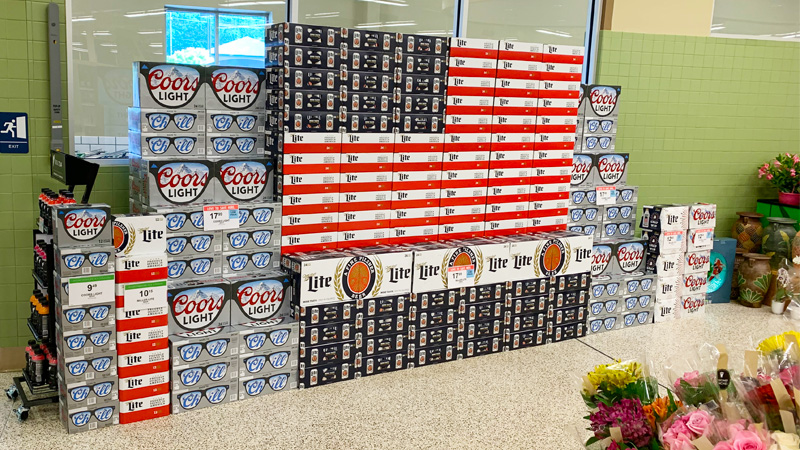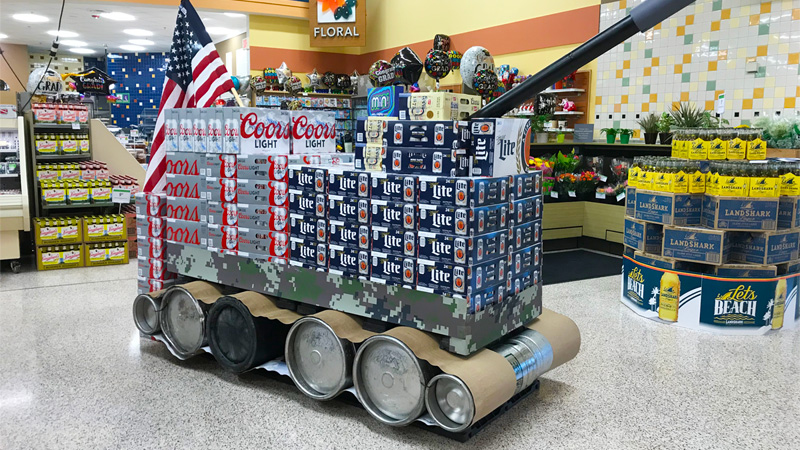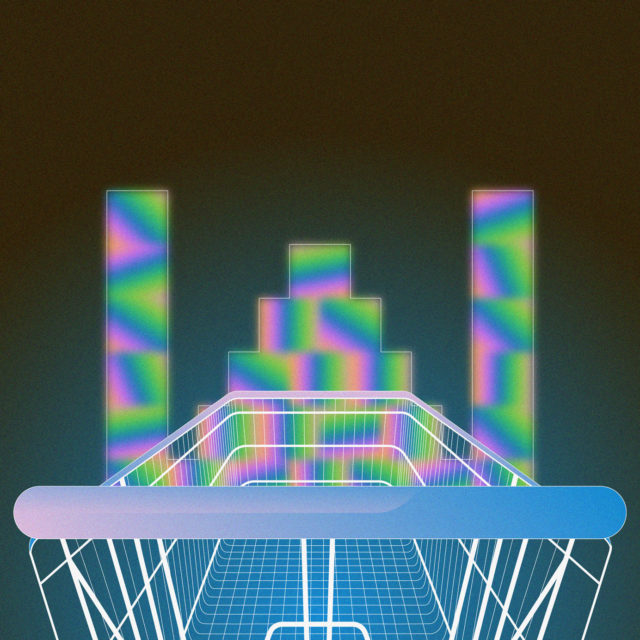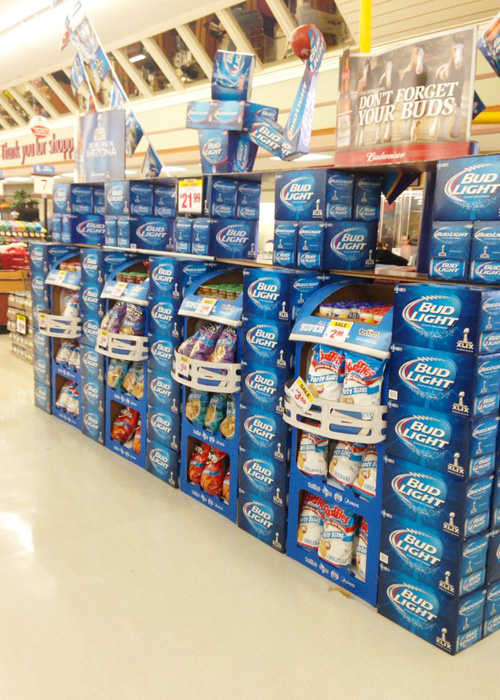One of the top priorities of a supermarket is to make it as easy as possible for shoppers to buy what they need. If a customer is looking for chips, the store conveniently has those in the chip aisle, but also on the end aisle at checkout to tempt those waiting in line. If mints fit the impulse buy, the store has 20 flavors conveniently located precisely where the credit card swipes. And beer? Surely beer is on many people’s grocery lists and shouldn’t be hard to find. That’s why a store manager strategically showcases a massive case sculpture, often in support of a local NFL team, to greet guests as they step into the store.
Selling beer in a grocery store shares a driving principle with real estate: location, location, location. Accessibility and aesthetics are essential to coercing a shopper to buy. And while a beer pyramid may look deceptively simple, few people realize how long it took to get that beer from the brewery to the supermarket floor.
To secure a retail display takes planning, negotiation, and logistical minutiae that can stretch into months. That’s why producers and distributors, whether selling a household name, artisan award-winner, or regional speciality, must consider the relationship building and pitching process for securing display space at a store — before promising infinite amounts of inventory or offering deep discounts in order to secure it.
Find Your Fit
Distributors or brands that are forging a new relationship with a grocery store or chain should first understand the best fit for their beer. E.K. Maccoll, vice president of sales and marketing for Breakside Brewery in Portland, Ore., explains that this is often determined by product availability. “I would say that it is less stringent to work with independent stores, as their expectations and guidelines are not as rigid,” he says. “Locations like Kroger and Albertsons are much more structured and once your products are placed in those locations, you need to be prepared to support them without running out of product.”
Availability restrictions are lessened when the brewery is in charge of its own production, says Maccoll. “Once a brand decides to make the investment in a production brewery and canning or bottling line, it somewhat makes the decision for you,” he says. “You then can determine, with your distributor, what type of stores you want to select for your product based on your capabilities.”
Once a beer brand has cemented product availability, it’s important to approach the grocery store relationship by distinguishing who makes the decision for buying beer (the buyer), and who approves displays (usually the GM or owner), and these are often different people. “Typically, negotiations are done at larger retail stores by a corporate buyer and the distributor,” Maccoll says. “However, for smaller grocery stores, beer reps can help influence some of these displays and/or case stacks. There usually needs to be a reason, like a new product release, seasonal release, or big consumer holiday like Thanksgiving. And having existing POS [point of sale] available to support the display can sway it even more.”
Confirming a meeting with the appropriate person can be onerous, unless you have an established relationship, Maccoll says, so making that connection is a team effort. “A large part of the relationship for the major chains falls to me [VP of sales and marketing], our owner, and our distributor,” he says. “It is key to have a close working relationship with your distributor to make sure the needs of the stores are being met and fulfilled.”
Darryl Robinson of Raise the Bar Beverages, a distributor in Calgary, Alberta, says the most successful way to build a good relationship with a grocery store or chain is with honest communication. “First and foremost, do not over-promise, and most importantly, tell the truth,” he says. “If you find out the store’s wants and needs and you can fulfill those needs, great, but if you can’t, do not tell them you can just get the sale.”

Be(er) Creative
For Alberto Farias, sales team lead for the Molson-Coors Beverage Company and its 60-plus distributors, the pitch to secure a footprint in the store should be creative. “Grabbing the attention of shoppers at retail and driving sales has always been in our distributors’ approach,” Farias says. And while product quality is a factor in a retailer’s decision, so are margins. “Success relies on proposing display ideas that will drive the most incremental sales to the stores. Retailers have limited floor space and they need to make choices based on what will generate stronger returns,” he says.
Acknowledging that bigger brands are often the ones with bigger displays, Farias adds that it’s not always a shoo-in. However, he says, “top-selling brands and packages, which require more inventory to satisfy demand, allow for bigger and more impactful displays at retail yielding stronger sales lifts.”

Don’t Forget to Execute
Once a display is agreed upon and finalized, the bulk of the activation responsibilities lie with the distributor and its reps. For Maccoll and Breakside Brewery, that begins with design. “Our Portland distributor, Maletis, actually has an in-house designer and specific software they use to design and map displays out,” he says.
For bigger beer brands like Molson Coors, Farias says, “marketing teams provide an array of retail tools throughout the year that are aligned to the brand’s strategy. Distributors leverage these tools to sell and execute displays at retail stores.” Supporting display tools that prove most successful are those that resonate with Americana, from branded coolers and surfboards to faux football helmets and miniature makeshift football fields.
From there, Farias recommends leaving space of at least a month for inventory to arrive from warehouses and for supporting display tools to be sourced. This can be “anywhere between two to six weeks. It can vary depending on the chain and the week. Holiday weeks typically require more planning and lead time,” he says.
But the work doesn’t end when the beer hits the floor. “Distributors lead the execution of displays. They partner with stores to ensure displays are restocked as needed,” Farias says.
Overall, the relationship between beer brands and grocery stores should be ongoing. Lengthy lead times means reaching out to the ideal grocery location and establishing display goals months in advance. And once the promotion is over, there’s always an opportunity to follow up with wrap reports that include highlights of the campaign, and perhaps note any of the first-time struggles in execution that can be overcome the next time.
A final piece of advice: Never stop communicating, and always leave the door open.
This story is a part of VP Pro, our free platform and newsletter for drinks industry professionals, covering wine, beer, liquor, and beyond. Sign up for VP Pro now!

